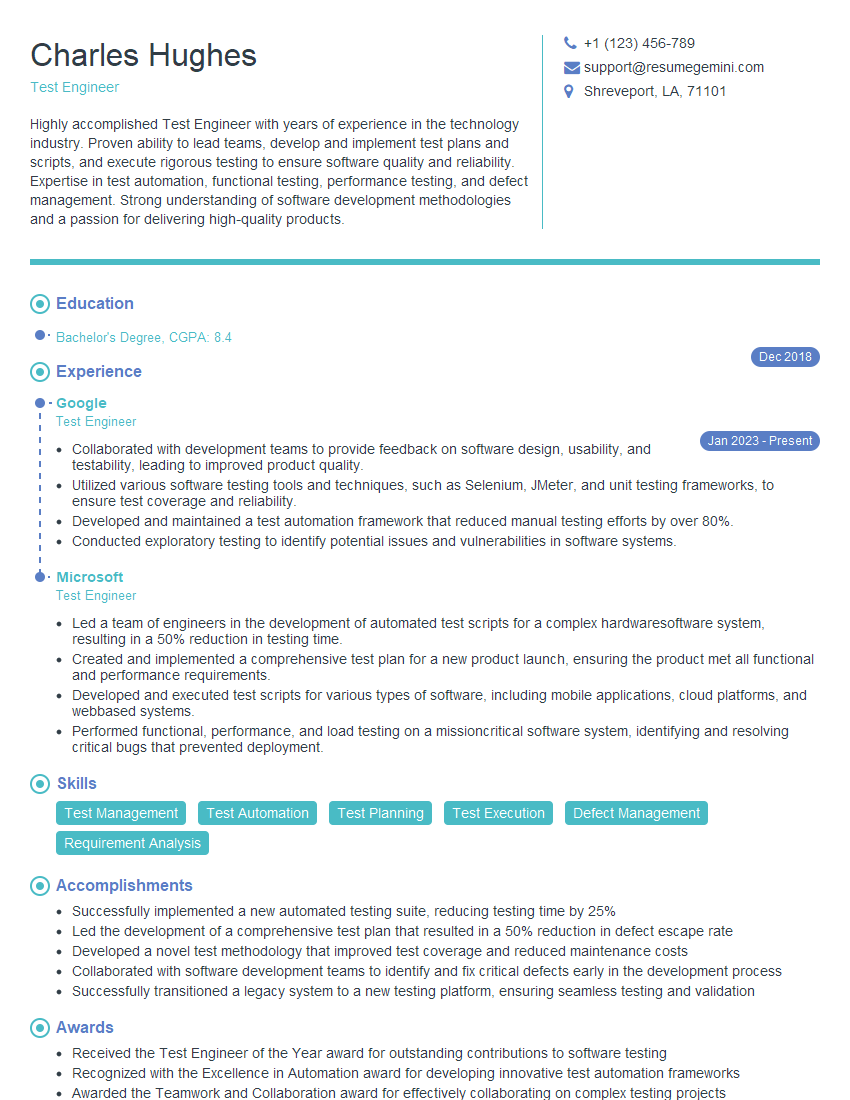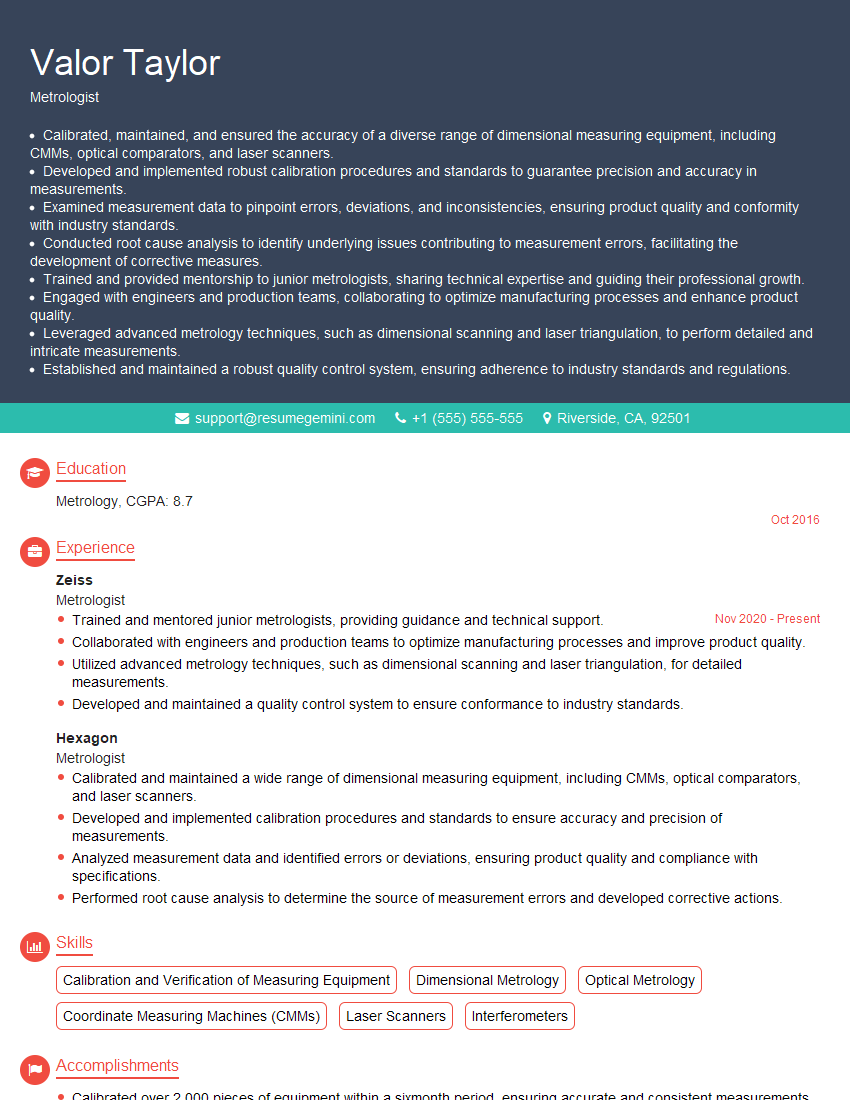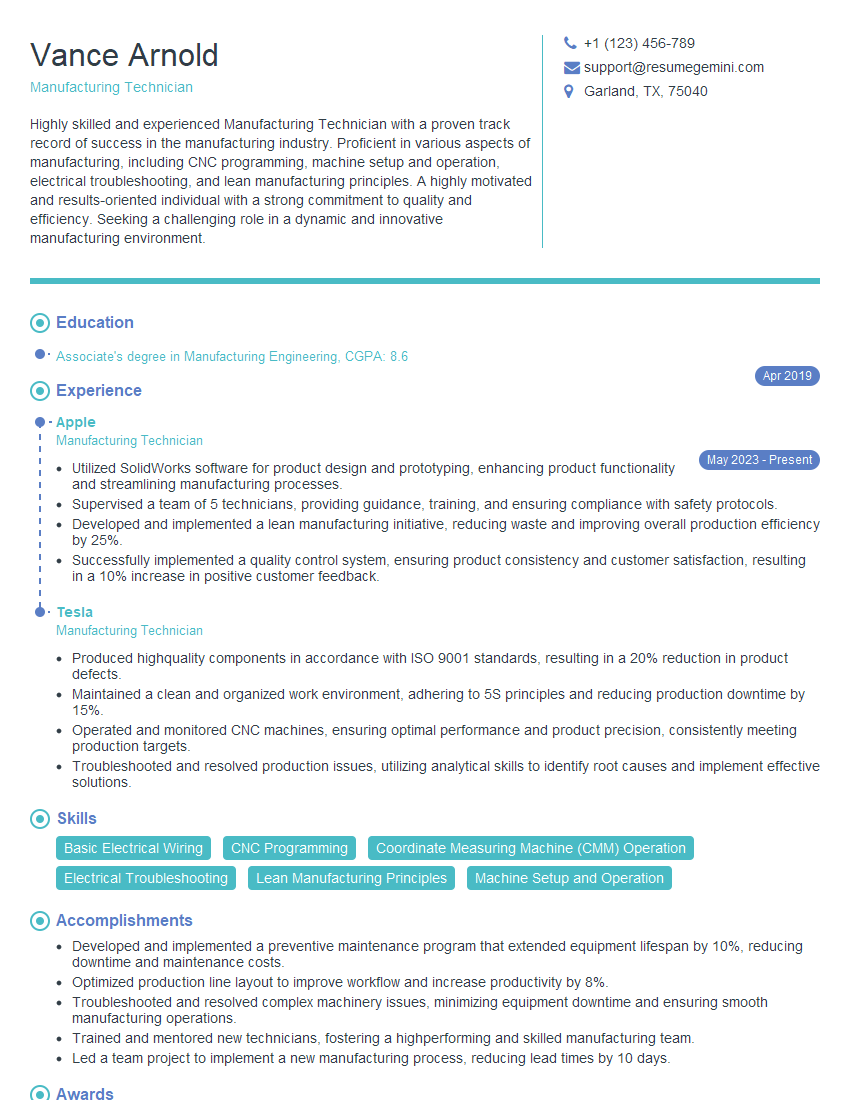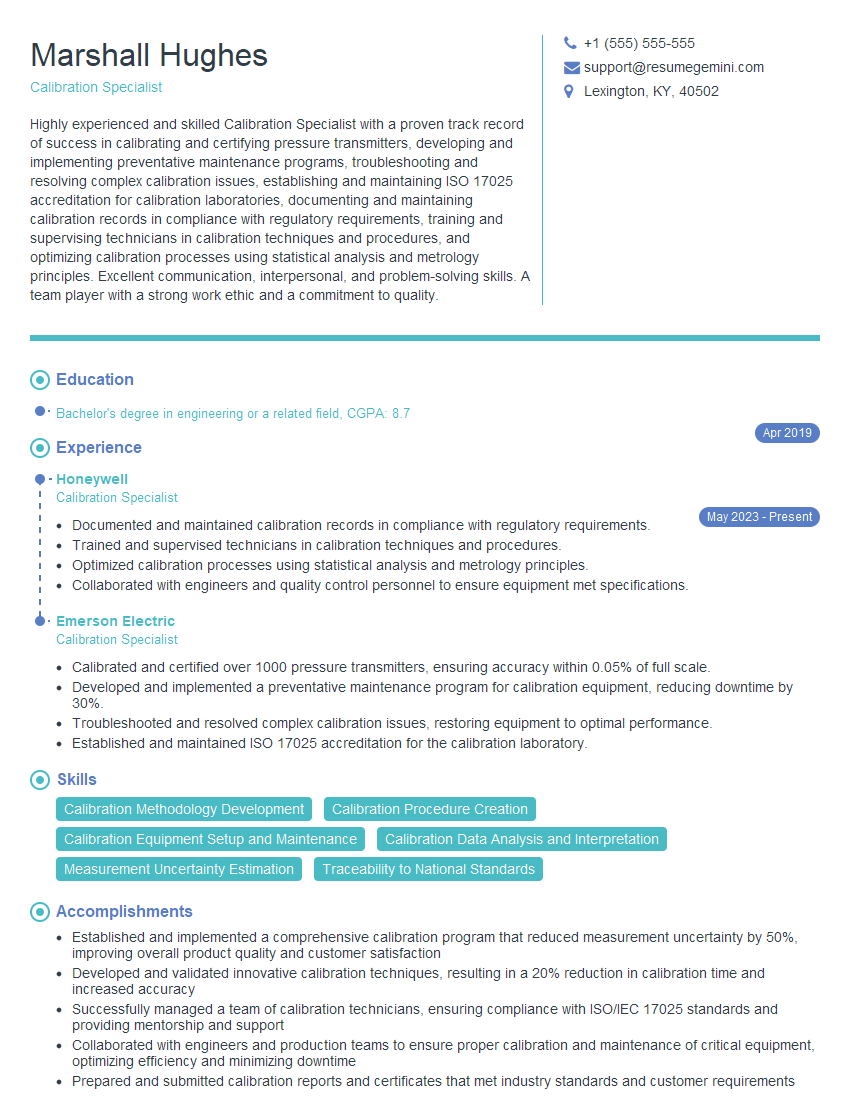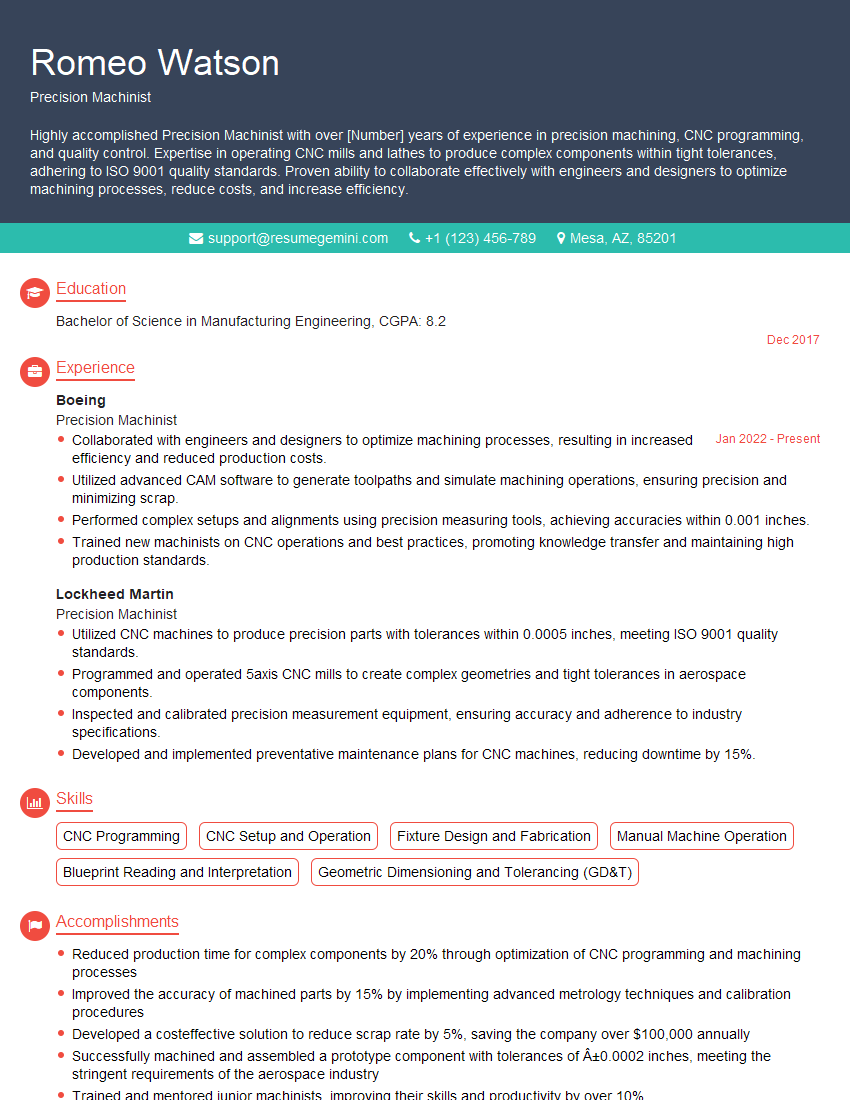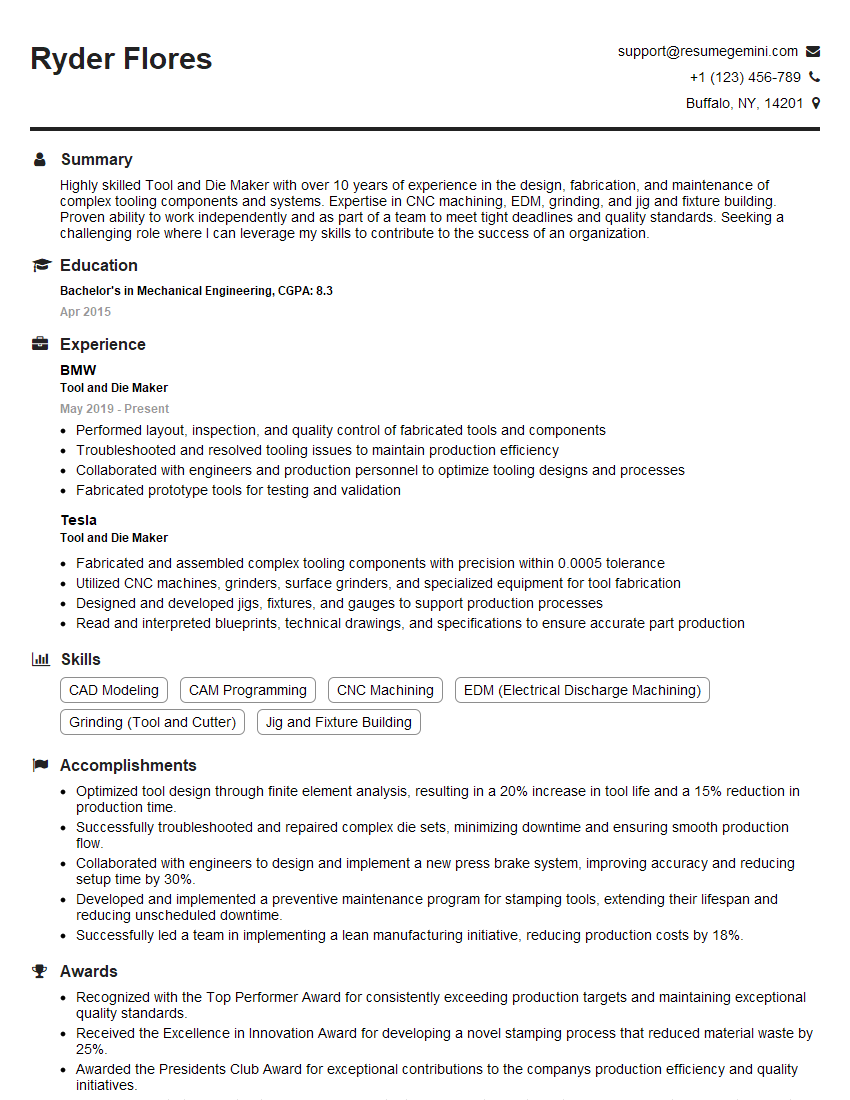The right preparation can turn an interview into an opportunity to showcase your expertise. This guide to Micrometer and Caliper Reading interview questions is your ultimate resource, providing key insights and tips to help you ace your responses and stand out as a top candidate.
Questions Asked in Micrometer and Caliper Reading Interview
Q 1. What is the difference between a micrometer and a caliper?
Micrometers and calipers are both precision measuring instruments used to determine the dimensions of objects, but they differ in their mechanisms and precision levels. A caliper uses two jaws to measure the distance between two points, similar to a ruler but with much greater accuracy. A micrometer, on the other hand, employs a screw mechanism with a precisely calibrated barrel and thimble for extremely fine measurements. Think of it this way: calipers are like a sophisticated ruler, while micrometers are like highly precise, adjustable screws for measuring incredibly small distances.
Q 2. Explain the principle of operation of a micrometer.
A micrometer’s principle of operation relies on a precisely threaded screw. The screw’s pitch (distance it moves per full rotation) is known and usually 0.5 mm or 1 mm. The thimble, which rotates along the barrel, is calibrated to indicate fractional turns of the screw. As you rotate the thimble, the spindle moves, accurately measuring the distance between the anvil (fixed jaw) and the spindle (movable jaw). The combination of the barrel’s markings and the thimble’s markings allows for extremely precise measurements, typically to 0.01mm or even 0.001mm.
Imagine a very fine screw threading its way along a perfectly calibrated rod. Each rotation of the screw moves the measuring tip a precise distance, and the fraction of a rotation is displayed on the thimble, providing extremely precise readings.
Q 3. How do you read a micrometer with a vernier scale?
Reading a micrometer with a vernier scale involves two steps. First, look at the barrel. The main markings on the barrel indicate millimeters (mm). Second, observe the thimble. The thimble’s markings usually show 0.01mm increments. The reading is the sum of the millimeter reading on the barrel and the 0.01mm reading on the thimble where the thimble’s line aligns precisely with the barrel’s line.
For example, if the barrel shows 5mm and the thimble’s line aligned with the barrel shows 23, the total measurement is 5.23mm. Mastering this requires practice, but understanding the combination of whole mm and fractional mm is crucial.
Q 4. How do you read a digital caliper?
Reading a digital caliper is significantly easier than a vernier micrometer. The measurement is directly displayed on a digital screen integrated into the caliper. Simply select the desired unit (mm, inches) and close the jaws on the object to be measured. The digital display will instantly show the measurement. Digital calipers often offer various functionalities like zero setting, different measurement units, and data storage.
Think of it as a digital ruler with a much higher level of accuracy.
Q 5. What are the common sources of error in micrometer and caliper measurements?
Several sources of error can affect micrometer and caliper measurements:
- Parallax error: Incorrectly viewing the scale due to eye position.
- Zero error: The instrument does not read zero when the jaws are closed.
- Temperature effects: Changes in temperature can affect the instrument’s dimensions.
- Wear and tear: Damage to the measuring surfaces can introduce inaccuracies.
- Improper handling: Dropping or applying excessive force can damage the instrument.
- Measurement pressure: Applying inconsistent force can lead to inconsistencies.
Q 6. How do you minimize measurement errors when using micrometers and calipers?
Minimizing measurement errors requires careful technique and instrument maintenance:
- Proper eye position: Ensure your eye is directly above the scale to avoid parallax error.
- Zero adjustment: Always check and adjust the zero setting before each measurement.
- Temperature control: Use instruments in a stable temperature environment.
- Regular calibration: Calibrate the instrument regularly against a known standard.
- Careful handling: Handle the instrument carefully and avoid dropping it.
- Consistent pressure: Apply consistent force when taking measurements.
- Clean the instrument: keep measuring surfaces clean and free of debris.
Q 7. What are the different types of micrometers?
Micrometers come in various types, each designed for specific applications:
- Outside micrometers: Measure the external dimensions of objects.
- Inside micrometers: Measure the internal dimensions of holes or bores.
- Depth micrometers: Measure the depth of holes or recesses.
- Tube micrometers: Measure the wall thickness of tubes.
- Vernier micrometers: Employ a vernier scale for increased precision.
- Digital micrometers: Feature a digital display for easy reading.
The choice of micrometer depends entirely on the specific measurement task.
Q 8. What are the different types of calipers?
Calipers come in various types, each designed for specific measurement needs. The most common are:
- Vernier Calipers: These are highly versatile and widely used for precise measurements of both internal and external dimensions. They utilize a vernier scale to achieve greater accuracy than a simple ruler.
- Digital Calipers: These calipers use electronic sensors to display the measurement directly on a digital screen, eliminating the need for manual interpretation of scales. They offer speed and ease of use, especially for repetitive measurements.
- Dial Calipers: Similar to vernier calipers in functionality, dial calipers use a rotating dial to indicate measurements. They are generally less precise than digital calipers but more robust.
- Inside/Outside Calipers: These are simpler calipers with two legs that can measure internal and external dimensions, though not as precisely as vernier or digital calipers. They are often used for quick, less demanding measurements.
- Depth Calipers: These calipers have a sliding jaw that allows for accurate measurement of depths, such as the depth of a hole or groove.
The choice of caliper type depends heavily on the application’s accuracy requirements, the types of measurements needed, and budget constraints. For instance, a machinist requiring highly precise measurements would opt for a digital caliper, while a carpenter might find inside/outside calipers sufficient for many tasks.
Q 9. Explain the concept of least count in micrometers and calipers.
The least count represents the smallest unit of measurement that an instrument can accurately display. It’s the difference between two consecutive markings on the scale. For both micrometers and calipers, understanding the least count is crucial for determining measurement uncertainty.
Micrometer: A micrometer typically has a least count of 0.01 mm (or 0.0005 inches). This means that the smallest increment you can reliably measure is one hundredth of a millimeter. For example, if a micrometer reads 10.23 mm, you know the measurement lies within the range of 10.225 mm and 10.235 mm.
Caliper: The least count of a vernier caliper depends on the specific design but usually ranges from 0.02 mm to 0.05 mm (or 0.001 to 0.002 inches). A digital caliper’s least count is determined by its display resolution, often 0.01 mm or higher.
Imagine trying to measure the diameter of a very thin wire. A ruler wouldn’t suffice; you need the higher precision of a micrometer, with its much smaller least count, to capture its true dimensions accurately.
Q 10. How do you calibrate a micrometer?
Micrometer calibration is a crucial step to ensure accurate measurements. It involves verifying that the micrometer reads zero when the jaws are closed and checking its accuracy across its measuring range. Here’s a typical procedure:
- Zero Calibration: Gently close the micrometer’s jaws. The reading should be exactly zero. If not, this is a zero error that needs to be accounted for in subsequent measurements (explained later). Some micrometers have a zero adjustment mechanism to correct this.
- Verification using Gauge Blocks: Use certified gauge blocks (precision-machined blocks with known dimensions) to check the micrometer’s accuracy at various points across its measuring range. Compare the micrometer’s reading to the known dimension of each gauge block. Any significant discrepancies indicate a calibration issue requiring professional attention.
- Documentation: Record all calibration results, including date, gauge blocks used, and any discrepancies found. This forms part of the instrument’s calibration history.
Professional calibration services are often employed for critical applications, especially where traceability to national standards is required. They use sophisticated equipment and procedures to ensure the highest accuracy.
Q 11. How do you calibrate a caliper?
Calipers, like micrometers, require calibration to ensure accuracy. The process is less complex than micrometer calibration but equally important:
- Zero Calibration: Close the caliper jaws firmly. The reading should be zero. If there’s a discrepancy, this is a zero error. While some digital calipers allow zero adjustment, others require this error to be noted and subtracted from subsequent readings.
- Verification using a known standard: Use a verified object of known length (e.g., a precisely measured block or ruler) to check the caliper’s accuracy. Compare the caliper’s reading to the known dimension. Any inconsistencies suggest a need for adjustment (if possible) or professional recalibration.
- Repeatability Check: Measure the same object several times to check for consistency. Significant variations indicate wear or damage requiring attention.
For simple calipers like inside/outside calipers, visual inspection for wear and tear on the jaws is also important. Significant wear might compromise accuracy.
Q 12. What are the safety precautions when using micrometers and calipers?
Safety when using micrometers and calipers is paramount. Here are some key precautions:
- Handle with care: Avoid dropping or impacting the instruments as this can damage their precision mechanisms.
- Use appropriate force: Apply only the necessary force to close the jaws. Excessive force can damage the instrument or the object being measured.
- Keep clean and dry: Avoid using the instruments in wet or dirty environments. Dirt and moisture can interfere with accuracy and cause corrosion.
- Store properly: Store the instruments in their protective cases when not in use to prevent damage and maintain accuracy.
- Never use for anything other than measurement: Don’t use them as screwdrivers or other tools. Their delicate construction is not designed for such use.
- Wear safety glasses: If using calipers with moving parts, safety glasses are recommended to protect against accidental injuries from flying debris.
Always treat these precision instruments with respect, as damage to them can lead to inaccurate measurements in critical applications.
Q 13. How do you clean and maintain micrometers and calipers?
Cleaning and maintaining micrometers and calipers are essential for their longevity and accuracy. Here’s a suggested approach:
- Cleaning: Gently wipe the measuring surfaces and other parts of the instrument with a soft, lint-free cloth. For stubborn dirt, use a mild solvent appropriate for the instrument’s material. Avoid harsh chemicals or abrasive cleaners.
- Lubrication (for some instruments): Some calipers and micrometers benefit from occasional lubrication of moving parts. Consult the manufacturer’s instructions to determine the appropriate lubricant and application method.
- Storage: Store the instrument in its protective case in a clean, dry environment to prevent corrosion and damage.
- Regular Inspection: Regularly check for any signs of wear, damage, or misalignment. Address any issues promptly to prevent further problems.
Proper cleaning and maintenance not only prolong the lifespan of these instruments but also ensure they maintain their precision for accurate measurements. Think of it like regular servicing of a car—it ensures its reliable operation.
Q 14. What is the significance of zero error in micrometer and caliper readings?
Zero error refers to a situation where the instrument doesn’t read zero when it should—when the jaws are closed for a micrometer or fully closed for a caliper. This error, if not accounted for, will lead to inaccurate readings in all measurements.
Significance: A zero error means every measurement will be off by the value of the error. For example, if a micrometer has a zero error of +0.02 mm, every measurement will be 0.02 mm too large. Similarly, if a caliper shows a -0.05mm zero error, every measurement will be 0.05mm too small.
How to deal with zero error:
- Correction during measurement: If the instrument doesn’t have a zero adjustment, you must subtract (for positive error) or add (for negative error) the zero error value from each measurement.
- Zero adjustment (if available): Some digital calipers and micrometers have a zero adjustment mechanism to correct the error. Use this feature to set the reading to zero when the jaws are closed.
Ignoring zero error can lead to significant inaccuracies in precision work, potentially causing errors in manufacturing or engineering projects, underscoring the need to always check and correct for this.
Q 15. How do you compensate for zero error?
Zero error, also known as an instrumental error, is a systematic error present in a measuring instrument even when no measurement is being taken. It’s like a bias in the scale – it always reads a little high or low, regardless of the actual value. To compensate, you need to identify and correct for this error.
How to compensate:
- Calibration: Most micrometers and calipers can be calibrated. This usually involves setting the instrument to zero using a gauge block (a precisely manufactured block of known dimensions) or by adjusting a zero-setting mechanism.
- Zero Reading: Before taking measurements, check the instrument’s reading with the jaws closed (for micrometers) or fully closed (for calipers). If it doesn’t read exactly zero, note this difference. Subtract (if reading positive) or add (if reading negative) this ‘zero error’ from all subsequent measurements to correct the readings.
- Record Keeping: Keep a record of the zero error for your particular instrument. This is crucial for consistent results, especially if you’re dealing with very precise measurements.
Example: If your micrometer consistently reads 0.02mm when closed, and you measure a piece to be 10.00mm, the actual measurement is 10.00mm – 0.02mm = 9.98mm.
Career Expert Tips:
- Ace those interviews! Prepare effectively by reviewing the Top 50 Most Common Interview Questions on ResumeGemini.
- Navigate your job search with confidence! Explore a wide range of Career Tips on ResumeGemini. Learn about common challenges and recommendations to overcome them.
- Craft the perfect resume! Master the Art of Resume Writing with ResumeGemini’s guide. Showcase your unique qualifications and achievements effectively.
- Don’t miss out on holiday savings! Build your dream resume with ResumeGemini’s ATS optimized templates.
Q 16. Describe the process of measuring the diameter of a cylindrical object using a micrometer.
Measuring the diameter of a cylindrical object with a micrometer is a precise process. Imagine you’re measuring the thickness of a very fine wire – a micrometer is perfect for that kind of precision.
Process:
- Check for Zero Error: Close the micrometer’s anvil and spindle. Ensure it reads zero. Compensate for any zero error as described above.
- Secure the Object: Gently place the cylindrical object between the anvil and spindle of the micrometer.
- Rotate the Thimble: Slowly rotate the thimble until you feel a slight resistance – this indicates that the object is firmly held, yet not squeezed.
- Read the Measurement: Read the measurement using both the sleeve (main scale) and the thimble (vernier scale). The sleeve shows the millimeter reading, and the thimble provides the fractional part (usually to the hundredth of a millimeter).
- Record the Measurement: Note down the complete measurement, including any error compensation.
- Repeat: Take several measurements at different points along the cylinder to account for variations in the object’s shape. Calculate the average for a more accurate result.
Example: If the sleeve shows 10mm and the thimble shows 0.25mm, the diameter is 10.25mm. Remember to account for any zero error.
Q 17. Describe the process of measuring the inside diameter of a cylindrical object using a caliper.
Measuring the inside diameter of a cylinder with a caliper is straightforward, but accuracy relies on careful technique. Imagine you need to measure the bore of a pipe – a caliper’s the tool for the job.
Process:
- Select the Appropriate Caliper: Use an inside caliper, which has two inward-facing measuring points.
- Adjust the Caliper: Carefully open the jaws of the caliper to a width slightly larger than the expected inside diameter of the cylinder.
- Insert the Caliper: Gently insert the caliper’s jaws into the cylindrical object, ensuring they touch the opposite walls of the cylinder.
- Tighten the Caliper: Close the jaws slightly until they firmly contact the inner surfaces, taking care not to force them.
- Read the Measurement: Read the measurement from the caliper’s scale.
- Record and Repeat: Record your reading. Repeat the process at multiple locations along the cylinder and average the results for improved accuracy.
Q 18. Describe the process of measuring the depth of a hole using a depth micrometer.
A depth micrometer is specifically designed for measuring the depth of a hole or recess. Think about inspecting a precisely machined component – a depth micrometer offers the precision needed.
Process:
- Check for Zero Error: Ensure the depth micrometer reads zero when the measuring rod is fully retracted.
- Position the Micrometer: Carefully place the base of the depth micrometer firmly and squarely against the surface around the hole.
- Extend the Rod: Slowly extend the measuring rod into the hole until the tip reaches the bottom.
- Read the Measurement: Read the measurement from the depth micrometer’s scale. This usually involves reading a main scale and a vernier scale.
- Record and Repeat: Note the reading and repeat the measurement at several points within the hole to account for any inconsistencies.
Q 19. How do you measure the thickness of a sheet metal using a caliper?
Measuring the thickness of sheet metal with a caliper is a common application. It’s much like measuring the thickness of a piece of paper, only potentially with greater precision.
Process:
- Choose an appropriate caliper: An outside caliper will be used for this measurement.
- Close the caliper jaws: Ensure the jaws of the caliper are closed.
- Position the sheet metal: Place the sheet metal between the caliper jaws.
- Gently close the caliper: Carefully close the caliper jaws until the sheet metal is held firmly between them.
- Read the measurement: Note the thickness of the sheet metal shown on the caliper’s scale.
- Repeat for accuracy: Measure the thickness at several different locations on the sheet metal, and average the readings for greater accuracy.
Q 20. How do you measure the width of a slot using a caliper?
Measuring the width of a slot with a caliper involves using the caliper’s jaws to span the distance across the slot. Think of measuring the gap between two parallel lines.
Process:
- Select an appropriate caliper: An outside caliper is best suited for this task.
- Align the jaws: Open the caliper jaws slightly wider than the anticipated width of the slot.
- Position the caliper: Carefully insert the caliper jaws into the slot, making sure the tips touch both sides of the slot.
- Gently close the jaws: Close the caliper jaws until the tips snugly fit against the sides of the slot without forcing them.
- Read the measurement: Observe the measurement on the caliper’s scale.
- Repeat for accuracy: Repeat this process at several points across the slot and average the readings to obtain a more reliable measure.
Q 21. What are the limitations of micrometers and calipers?
Micrometers and calipers, while incredibly useful, do have limitations. Their accuracy is limited by their resolution (the smallest increment they can measure) and their potential for user error.
Limitations:
- Resolution: Micrometers and calipers have a finite resolution. For instance, a standard micrometer might measure to 0.01mm, but features smaller than that cannot be accurately measured. This limits their precision for extremely small objects.
- Parallax Error: Incorrect positioning of the eye while reading the scale can lead to parallax error, resulting in inaccurate measurements.
- Wear and Tear: Over time, the jaws of micrometers and calipers can wear down, affecting their accuracy. Regular calibration is important.
- Limited Range: Both tools are generally designed for a limited measuring range. You cannot use a small caliper to measure the diameter of a large pipe.
- User Skill: Accurate measurements depend heavily on the user’s skill and technique. Proper handling and calibration are crucial for reliable results.
- Shape Limitations: Both micrometers and calipers are best suited for measuring straight, regular shapes. Measuring irregular or curved surfaces accurately is challenging.
Therefore, it’s essential to choose the right instrument for the task and be aware of these limitations to ensure accurate and reliable measurements.
Q 22. What are the advantages of using digital micrometers and calipers over analog ones?
Digital micrometers and calipers offer significant advantages over their analog counterparts primarily due to increased accuracy and ease of use. Analog instruments rely on visual interpretation of markings, prone to parallax error (misreading due to viewing angle) and subjective interpretation. Digital versions eliminate this by providing a direct numerical readout on an LCD screen.
- Increased Accuracy: Digital instruments typically offer higher resolution, often to 0.001mm or 0.0001 inches, significantly reducing measurement uncertainty. This is crucial in precision engineering and manufacturing.
- Reduced Error: Parallax error, a common problem with analog tools, is completely avoided with digital readouts. The digital display provides an objective measurement regardless of the user’s viewing angle.
- Improved Efficiency: Faster and easier readings reduce time spent on measurement, leading to increased productivity. Data can often be transferred directly to a computer or data acquisition system, enhancing workflow.
- Data Logging Capabilities: Some digital instruments allow for data logging, which is crucial for traceability and quality control in manufacturing processes. This capability is absent in analog instruments.
Imagine trying to measure the thickness of a thin wire using an analog caliper. The slight difference between the actual measurement and the user’s visual estimation could lead to significant inaccuracies. A digital caliper, on the other hand, would provide a precise, unambiguous numerical value.
Q 23. How would you select the appropriate micrometer or caliper for a specific measurement task?
Selecting the right micrometer or caliper depends on the specific measurement task and the required precision. Consider these factors:
- Range of Measurement: Determine the maximum and minimum dimensions you need to measure. Choose an instrument with a range that comfortably encompasses your needs. A caliper designed for large parts is unsuitable for tiny components and vice-versa.
- Required Precision: The level of accuracy needed dictates the instrument’s resolution. For high-precision applications, a digital micrometer with a resolution of 0.001mm or better might be necessary. Less precise applications might suffice with a caliper offering 0.1mm resolution.
- Type of Measurement: Inside, outside, depth, or step measurements require different caliper types. Micrometers are typically used for external measurements with high precision.
- Material and Surface Finish: The material being measured and its surface finish affect the choice of instrument. Some materials require specialized tips or jaws to prevent damage or slippage.
- Budget and Durability: Balance the cost with the expected frequency of use and the durability requirements. High-quality instruments usually offer better precision and longevity.
For instance, if you are measuring the thickness of a sheet of metal within a tolerance of 0.01mm, you would need a digital micrometer with at least that resolution. However, if you’re measuring the diameter of a large pipe within a tolerance of 1mm, a standard analog caliper would suffice.
Q 24. Explain the difference between inside and outside calipers.
Inside and outside calipers differ in their functionality and the types of measurements they perform:
- Outside Calipers: These are used to measure the external dimensions of an object, such as the diameter of a rod or the width of a block. The jaws are positioned around the object to capture its external size. They are the most common type of caliper.
- Inside Calipers: These are used to measure the internal dimensions of an object, such as the diameter of a hole or the width of a groove. The tips of the caliper are inserted into the object’s opening to gauge its internal size.
Think of it like this: An outside caliper measures the ‘outside’ of something, while an inside caliper measures the ‘inside’. Both are essential tools for comprehensive dimensional measurement.
Q 25. What is a vernier scale and how does it increase the precision of measurement?
A vernier scale is an auxiliary scale that increases the precision of a measuring instrument. It’s essentially a secondary scale that slides alongside the main scale. The main scale provides larger units (like millimeters), while the vernier scale provides finer subdivisions, improving the resolution significantly. It achieves this by using a slightly different graduation on the vernier scale compared to the main scale.
For example, a vernier caliper might have a main scale with 1mm markings, but the vernier scale has 10 divisions that span 9mm on the main scale. This allows the user to read measurements to 0.1mm (one-tenth of a millimeter), by observing where the vernier scale lines up precisely with the main scale. This method is often clearer than trying to estimate the reading to the tenth of a millimeter using only the main scale alone.
Q 26. How do you identify a damaged or worn-out micrometer or caliper?
Identifying a damaged or worn-out micrometer or caliper requires careful inspection:
- Check for Damage to Jaws: Examine the jaws for any nicks, burrs, or significant wear. Damaged jaws will lead to inaccurate measurements. Look for any signs of bending or misalignment.
- Inspect the Vernier Scale (if applicable): Look for any damage or deterioration of markings on the vernier scale. Poorly defined markings hinder precise readings.
- Verify Smooth Movement: The moving parts (jaws, thimble) should slide smoothly without any binding or sticking. Sticking indicates damage or debris that needs cleaning.
- Test for Zero Setting: With the jaws closed, ensure the instrument reads zero. A consistent non-zero reading indicates miscalibration or damage.
- Look for Loose or Damaged Parts: Check all the fastening screws and locking mechanisms for tightness and proper function. Loose parts can lead to inaccurate measurements.
- Examine the Finish: Check for corrosion or significant wear on the instrument’s body. Severe wear might indicate extensive use and a potential loss of precision.
A simple test is to measure a known standard object (a gauge block, for example). Any significant deviation from the expected value suggests a problem with the instrument’s accuracy. If in doubt, it is best to consult a metrology expert for professional calibration and verification.
Q 27. What are the common units of measurement used with micrometers and calipers?
The common units of measurement used with micrometers and calipers are:
- Millimeters (mm): The most prevalent unit in the metric system. Widely used in many engineering and manufacturing applications worldwide.
- Inches (in): Primarily used in imperial measurement systems. Frequently seen in certain industries and countries.
- Thousandths of an inch (0.001 in): Common in precision machining and other applications requiring high accuracy in imperial units.
Many digital instruments allow for switching between different units of measurement (mm and inches).
Q 28. Explain the importance of proper measurement techniques for accurate results.
Proper measurement techniques are paramount for obtaining accurate results with micrometers and calipers. Inaccurate techniques can easily introduce errors larger than the instrument’s resolution.
- Proper Handling: Avoid dropping or impacting the instrument, as this can damage the delicate internal mechanisms.
- Cleanliness: Ensure both the instrument and the object being measured are clean and free from debris. Dirt or grease on the jaws can lead to slippage and inaccurate readings.
- Applying the Right Pressure: Apply consistent, moderate pressure when measuring. Excessive pressure can deform the measured object, particularly soft materials. Insufficient pressure can lead to slipping and incorrect readings.
- Avoiding Parallax Error (for analog instruments): When reading an analog instrument, ensure your eye is directly aligned with the measurement scale to avoid parallax error.
- Zero Setting: Always verify that the instrument is correctly zeroed before taking measurements. A consistent non-zero reading indicates miscalibration.
- Multiple Measurements: Take multiple measurements at different locations on the object and average the results to improve accuracy and reduce the impact of small imperfections on the object’s surface.
- Environmental Factors: Account for environmental factors like temperature, which can affect material dimensions. Micrometer readings can be influenced by temperature variations.
By following these techniques, you ensure that any errors are minimized, and the measurement obtained accurately reflects the dimensions of the measured object.
Key Topics to Learn for Micrometer and Caliper Reading Interview
- Micrometer Fundamentals: Understanding core concepts like metrics, registries, and meters. Explore different meter types and their appropriate use cases.
- Micrometer Integrations: Familiarize yourself with integrating Micrometer with popular frameworks like Spring Boot and how to configure different reporting mechanisms (e.g., Prometheus, Graphite).
- Custom Metrics Implementation: Learn how to create and instrument custom metrics to monitor specific aspects of your applications.
- Caliper Reading Principles: Grasp the foundational concepts of Caliper, focusing on its role in performance testing and analysis.
- Caliper Experiment Design: Understand how to design effective Caliper experiments to accurately measure performance characteristics of your systems.
- Interpreting Caliper Results: Learn to analyze and interpret the results generated by Caliper to identify performance bottlenecks and areas for optimization.
- Micrometer and Caliper Integration: Explore how Micrometer can be used to gather performance data that complements Caliper’s analysis.
- Performance Tuning Strategies: Based on insights gained from Micrometer and Caliper, understand and articulate effective strategies for application performance optimization.
- Problem-solving with Micrometer and Caliper: Practice diagnosing performance issues using data collected from both tools. Consider scenarios involving unexpected metrics or performance anomalies.
Next Steps
Mastering Micrometer and Caliper will significantly enhance your skills in application monitoring and performance optimization, opening doors to exciting career opportunities in software engineering and DevOps. To maximize your chances of landing your dream role, it’s crucial to present your skills effectively. Building an ATS-friendly resume is key to getting your application noticed. ResumeGemini is a trusted resource to help you craft a compelling and professional resume that highlights your expertise in Micrometer and Caliper. Examples of resumes tailored to these technologies are available to guide you. Take the next step and build a resume that truly showcases your capabilities!
Explore more articles
Users Rating of Our Blogs
Share Your Experience
We value your feedback! Please rate our content and share your thoughts (optional).
What Readers Say About Our Blog
Hello,
We found issues with your domain’s email setup that may be sending your messages to spam or blocking them completely. InboxShield Mini shows you how to fix it in minutes — no tech skills required.
Scan your domain now for details: https://inboxshield-mini.com/
— Adam @ InboxShield Mini
Reply STOP to unsubscribe
Hi, are you owner of interviewgemini.com? What if I told you I could help you find extra time in your schedule, reconnect with leads you didn’t even realize you missed, and bring in more “I want to work with you” conversations, without increasing your ad spend or hiring a full-time employee?
All with a flexible, budget-friendly service that could easily pay for itself. Sounds good?
Would it be nice to jump on a quick 10-minute call so I can show you exactly how we make this work?
Best,
Hapei
Marketing Director
Hey, I know you’re the owner of interviewgemini.com. I’ll be quick.
Fundraising for your business is tough and time-consuming. We make it easier by guaranteeing two private investor meetings each month, for six months. No demos, no pitch events – just direct introductions to active investors matched to your startup.
If youR17;re raising, this could help you build real momentum. Want me to send more info?
Hi, I represent an SEO company that specialises in getting you AI citations and higher rankings on Google. I’d like to offer you a 100% free SEO audit for your website. Would you be interested?
Hi, I represent an SEO company that specialises in getting you AI citations and higher rankings on Google. I’d like to offer you a 100% free SEO audit for your website. Would you be interested?
good





